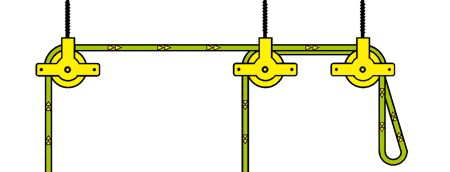| Questions About The Product Options | |
What do ceiling airers come with as standard? Our ceiling airers are supplied with everything you will need for a standard installation. This includes a pair of rack ends, a full working pulley system comprising of one double pulley, one single pulley, 10 meters of pulley rope, a wall cleat hook, and a choice of different length wooden laths. We also provide a full set of instructions. These can be viewed online here |
|
What size wooden laths / slats do you offer and how do I decide which lenth to choose? For customer based in the UK, we can supply wooden laths in lengths of up to 1.8m long. These typically come in 0.9m, 1.2m, 1.5m and 1.8m sets as standard, which can be cut to size if required. Our traditional airers are also available as a kit allowing you to add your own laths. For customers outside the UK, the lengths we offer depend on shipping restrictions and are listed accordingly. It
is important to choose a length of lath which is at least 30cm longer
than the distance between the two pulleys, so that the wooden slats
can protrude the rack ends at each end of the clothes airer. These
can be longer if needed however they should allow an overhang of
at least 30cm. Remember the wooden slats can be cut to size if required
allowing you to get the exact fit for the space provided. |
|
Why would I need an extra double pulley and / or sash cord extension?
Our ceiling airers are supplied with one double and one single pulley as standard, which is ideal for locations where the clothes airer is likely to be close to the adjacent wall and where the cleat hook will sit. Adding a second double pulley and sash cord extension allows you to position the airer away from the wall, allowing you to run the rope across the ceiling and down the wall at a right angle. The option for an extra double pulley is available when placing your order, or an additional pulley can be purchased separately here |
|
How do I work out the length of sash cord required for a standard or tall ceiling? We supply our ceiling airers with 10m of pulley rope as standard, which allows for the height of most ceilings. For those with particularly heigh ceilings, we have the option to add an additional 10m of sash cord to your order, making 20m of pulley rope in total. To work out the amount of pulley rope needed, multiply the ceiling height by four. This is the number of times the rope runs up and down throughout the system. If you have opted to add an extra double pulley, then add twice the distance between the two double pulleys on top. |
|
What are the hanging hooks for and why would I need them? When placing your order there is the option to add a set of 8 stainless steel hanging hooks. These are designed to fit over the airer laths and are ball tipped to help hold them in place. They are ideal for hanging small items of laundry as well as other items such as pots and pans or dried herbs. Although not essential they are a lovely addition to the drying rack giving it a more diverse range of uses. |
|
|

